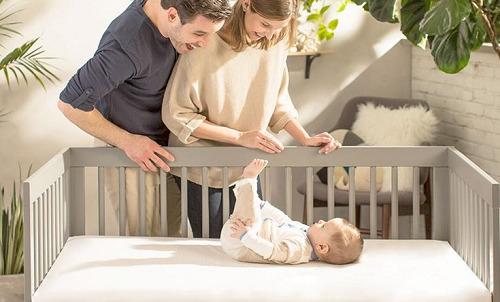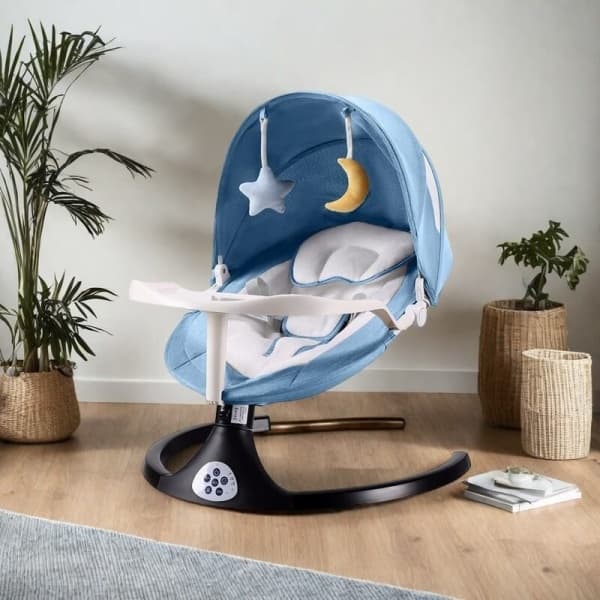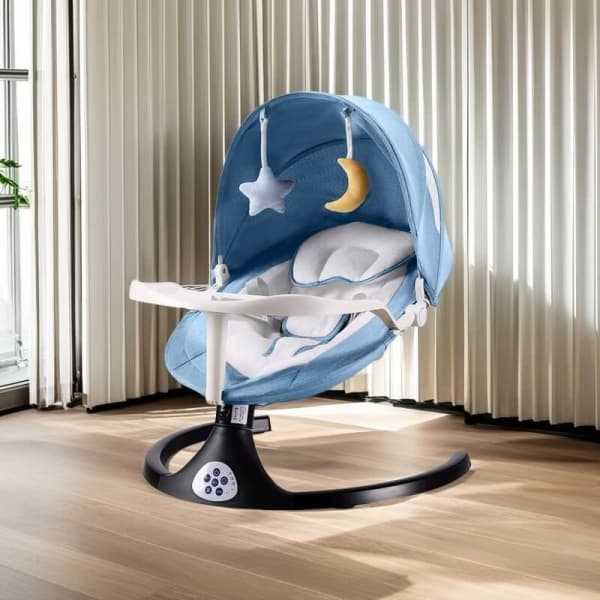The joys of parenthood are accompanied by many issues, such as getting your newborn to sleep soundly. As they mature, it is time to consider switching to a crib.
Given that sleep is a learned habit, crib transition can be a little stressful. Developing appropriate sleep patterns will be critical during this transition, as well as in preventing future sleep disorders.
Here are some helpful recommendations for getting your infant to sleep in a crib. We will also look at common concerns, suggest practical solutions, and provide advice on when to seek professional assistance.
Why Your Baby Does Not Want to Sleep in a Crib?
Infants always spend their early years sleeping, sleeping about 14 to 17 hours a day. Although many parents want to put their babies in a crib, they find that their babies always wake up or cry for this, as if they don’t want to stay in the crib.
By understanding the following reasons why babies don’t want to sleep, you can better solve the problem.
1. Reasons for Long-Term Difficulty Falling Asleep in a Crib
Separation Anxiety: As newborns grow, they become attached to their caregivers. This emotional attachment can cause anxiety when taken away, making cradle sleep difficult. Babies typically develop separation anxiety at about 8 months old. This is a natural developmental stage that often ends on its own around the age of two.
Sleep Regression: Sleep regression is a period of time during which an infant or toddler’s sleeping routine changes negatively. Sleep regressions vary from newborn to infant, although they usually occur around the ages of 4, 8, and 18 months. During these times, babies may reject sleeping in their cribs due to interrupted sleep patterns.
Developmental Milestones: Sleep may be briefly disrupted during developmental milestones such as learning to crawl or sit up. Similar to rolling, these physical developmental milestones can have a significant impact on sleep for some newborns who are unable to stop practicing the skills in bed! This can cause greater alertness and aversion to sleeping in their cribs.
Sleep Associations: also known as sleep habits, are the things a child learns to need to fall asleep, such as nursing, rocking, or being held by their parents. These linkages can lead to reliance on external cues for sleep.
2. Reasons Why It Is Sometimes Difficult to Fall Asleep in the Crib
Lengthy Daytime Naps: As newborns grow, they require fewer naps during the day and can sleep longer at night. If one day you find that your baby is always reluctant to fall asleep at night, then you should recall whether your baby slept for longer than usual during the day.
Overstimulation or Overtiredness: While daytime activities assist in maintaining a day-night pattern, babies that experience excessive excitement and stimulation in the evening may have difficulty falling asleep. Remember not to prevent your baby from sleeping during the day just to make him sleep longer at night, as this can also easily cause excessive fatigue.
Teething: According to the American Academy of Pediatrics, the pain and discomfort associated with teething can keep babies awake. Babies that are teething may have difficulties sleeping, become cranky, drool excessively, bite more than normal, or refuse to eat.
Illness: Pain, coughing, and itching, these symptoms usually disturb the baby’s sleep. When you repeatedly comfort your baby, but he always cries or refuses to fall asleep, you should first check whether the baby is sick.
Environmental Factors: A baby may not feel secure in the cot due to noise, light, an uncomfortable room temperature, or an unusual sleeping environment.
How To Get a Baby to Sleep in a Crib Instead of in Arms?

Seeing your infant fall asleep in your arms is one of the most enchanting experiences a parent can have. Then comes the part that every parent fears: you gently put them in the crib, and then they open their eyes and let out a piercing cry of protest.
What causes this to occur? Are you doing something incorrectly?
Absolutely not. Your child’s preference to remain in your arms can be explained by a variety of biological and emotional factors, and this behavior is very normal.
Babies are accustomed to the continual rocking and swaying they feel in the womb. Think about it: your kid spent nine months tucked away in the warmth of the womb, supported by the soft swing of your every motion. Once they’re born, your touch, heartbeat, and warmth mimic that familiar safety.
Our young ones construe the world through their senses, which is why the warmth and tenderness of your arms as a caregiver soothes them.
Additionally, holding your baby can regulate their body temperature. Your body keeps your little one warm and comfy by regulating their body temperature.
Suggestions for Transitioning:
We understand that it’s not always possible to hold your infant when they snooze. You also need breaks! How can you respect their desire for comfort while assisting them in making the gentle transition to crib sleep?
1. Put your baby in a crib as soon as possible after birth, The younger the baby, the easier it is to help them form habits, such as sleeping in a crib, because they are more adaptable in the first few months.
2. Begin by letting your baby take one crib nap per day, or letting your baby play in the crib during nap time so they are used to the area when they wake up.
3. Before bed, cuddle and soothe your baby to a comfortable, familiar feeling that will carry through into sleep.
4. Swaddling your little one can help them sleep better because it simulates comfort similar to that of being in the womb. Once your baby can roll over, switch to a wearable sleep sack.
5. If your baby is used to being held or rocked to sleep, consider introducing gentle sleep training techniques like the “Ferber Method” (graduated check-ins) or the “Chair Method” (gradually moving further away from the crib as your baby falls asleep). These methods help the baby learn to self-soothe while gradually reducing reliance on being held.
How to Get Your Baby to Sleep in a Crib After Co-Sleeping?

Some parents choose to sleep in the same bed with their baby, perhaps because they are first-time parents, are too worried about their baby, or just want to be more convenient when caring for their baby.
But no matter the reason, it is not recommended that caregivers and babies sleep in the same bed, as this increases the risk of SIDS. The safest option to co-sleep with your baby is to share a room, which means your baby sleeps in your bedroom in her crib, bassinet, or playard.
No matter how much your baby resists sleeping in the crib, you should stop sleeping in the same bed with your baby immediately. Using a bedside crib also makes it easier to feed and keep an eye on them at night.
What You can Do?
After you and your baby have been close for a long time (especially sleeping in the same bed), it is always challenging to let them sleep alone in the crib. They may react violently, feel upset and scared, and refuse to be put in the crib.
Nonetheless, there comes a moment when switching to a crib feels essential for babies to learn to sleep independently and for parents to regain some space. Listed below are a few pointers to make the transition smooth.
1. Invest in a bedside crib or co-sleeper bassinet and place them next to your bed (ideally connected) so your baby can also sense your smell and voice. As your baby gets used to sleeping in a crib, gradually move the crib away from your bed.
2. Co-sleeping is often accompanied by frequent nighttime feedings. If your baby is used to breastfeeding or bottle-feeding to sleep, start with shorter feedings or fewer nighttime feedings.
3. If your baby cries after being placed in the crib, comfort them with a gentle pat or soothing words from a distance, but try not to pick them up right away.
4. Make the crib a familiar, comforting place, such as using familiar scents (like your shirt) or soft, non-toxic bedding.
5. When co-sleeping, babies often develop strong sleep associations with physical closeness. When you move your baby to the crib, you can introduce new sleep associations, such as bedtime songs or stuffed animals, to encourage them to fall asleep alone.
What to Do When Your Baby Wakes in the Night?

Have you ever wondered why your newborn seems to wake up so often at night? It can feel exhausting, but it is common for them to wake up a few times each night for the first several months. Babies often wake up at night to meet numerous physical and developmental demands.
Reasons Why Babies Wake up Frequently at Night
Understanding why it happens can make responding a little easier and give you the tools to gently guide your baby toward better sleep patterns.
Feeding: Babies, particularly those under six months old, often wake up for overnight feedings. The amount of physical and mental growth that occurs in these few months is immense, therefore they require enough nutrients.
Sleep cycle transitions: Babies have distinct sleep cycles and may wake momentarily during transitions. Your baby’s sleep cycle is fewer than 60 minutes. So, every 45 minutes to an hour, your baby will fall into a light, easily disturbed sleep, or even momentarily wake up, and wiggle, fidget, and emit a short moan, or cry. If they cannot self-soothe, they are likely to wake up.
Discomfort: Teething, illness, or a damp diaper can all cause pain, prompting a wake. Again, because newborns can’t fix their problems, they’ll be sure to let you know if something is disrupting their sleep.
Suggestions for Handling Night Waking
While what you do depends on what is triggering the night waking, there are some do’s and don’ts for putting a baby back to sleep.
Give your baby time to self-soothe: Unless your baby is sobbing, allow them a few moments to fall back asleep.
Determine whether their basic requirements have been satisfied: Have you fed your baby? Changed the diaper? Are they feeling warm or cold? Sometimes the answer is as simple as feeding the baby, switching their diaper, or swaddling them again.
Try to determine if they are in pain: If your baby has been chewing on things during the day, they are most likely teething, and a gentle gum massage or an age-appropriate amount of medication may be beneficial. If they appear to be gassy, try doing some bicycle kicks or giving them some gas drops. Be sure to consult your pediatrician first before giving any medication.
Use gentle soothing techniques: Rocking, stroking, or using a white noise machine can help your baby calm without promoting a need to be held.
How to Prevent Frequent Night Wakings?
Create a peaceful nighttime routine: Most newborns are highly receptive to a bedtime routine at the age of 6 to 8 weeks. Starting a calming routine approximately 20 to 30 minutes before bedtime will help soothe your child and prepare them for a good night’s sleep.
Increase daytime feeding: If your kid is waking up every hour, it’s time to start feeding him more during the day. Breastfed neonates require a minimum of 10 to 12 feedings per day, while bottle-fed babies require six to eight feedings each day.
Other Tips to Help Your Baby Sleep in the Crib

1. Maintain a Safe Sleeping Environment: Safety is the top issue, so remember to lay them to bed on their back, on a firm surface, with no loose objects. Babies are also at risk when sleeping on tilted surfaces, such as a baby swing.
2. Use White Noise: Life in the womb was never extremely quiet. Instead, there was a steady hum of white noise and muted sounds. Consider utilizing a white noise machine to drown out any distracting sounds, allowing your infant to feel more safe and peaceful.
3. Put Them down Drowsy but Awake: Experts recommend putting your newborn in their cot before they have fallen asleep. If you let them fall asleep in your arms first, they will notice the difference in the environment and wake up again.
4. Keep the Daytime Active and the Nighttime Quiet: Parents and guardians can educate babies that the daytime is for playing and the nighttime is for sleeping by adjusting the surroundings based on the time of day. While some people are anxious to wake a sleeping newborn, exposing them to daylight sunshine and ambient noises helps them develop day-night rhythms.
5. Consider Sleep Training: If a baby continues to struggle to fall asleep, their parent or caregiver should explore sleep training. Sleep training methods include allowing newborns to “cry it out,” delaying progressively longer periods of time before attending to babies at night, and gradually “fading out” the amount of time a caregiver spends with a baby.
When to Seek Professional Help?
Sleep disorders occur when your kid has difficulty falling or staying asleep at night, and if left untreated, your child may experience difficulties functioning or develop health concerns. Some of the most common sleep disorders include:
- Sleep apnea is a sleeping condition in which children’s breathing stops as they sleep. Children suffer from two forms of sleep apnea: obstructive and central. Sleep apnea can impair cognition and behavior, as well as cause cardiac problems. If you observe symptoms such as weird pauses in breathing, or gasping in your child, get medical attention right away.
- Night terrors, which are more common in children than in adults, cause a person to awaken abruptly from sleep, seeming terrified or disturbed and frequently sobbing, yelling, and occasionally sleepwalking.
- Parasomnias are unpleasant physical episodes or sensations that frequently occur in young children. Sleepwalking, confusion upon awakening, and sleep terrors are all common symptoms of parasomnias.
If your baby’s sleep issues persist despite implementing the above-recommended sleep measures, visit a pediatrician or sleep consultant. They can help rule out any underlying conditions that may be interfering with sleep.
Conclusion
Getting your baby to sleep in the crib, like all other aspects of parenting, is a continuous learning experience for both of you. Incorporating what works, creating your routines, and remaining consistent can all help you promote excellent sleep habits.
For businesses looking to support families on this journey, partnering with Clafbebe is a valuable opportunity. Our high-quality, thoughtfully designed cribs help ensure safer, more comforting sleep.
Recommended Related Articles:
- Best Portable Cribs: Grandparents’ Sleepover Guide
- When to Transition Baby to Crib?
- Crib Types and Styles: A Complete Guide
- Best Materials for Baby Crib
- Crib Sizes: A Complete Guide
- Crib Safety Standards and Certifications: An Ultimate Guide
- How Much Weight Can a Crib Hold?
- When to Lower the Crib Mattress?
- Top 20 Crib Manufacturers in 2025














